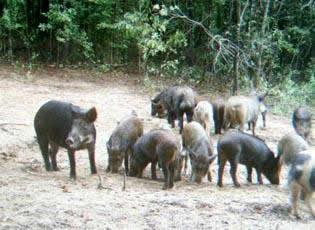 May 16, 2019 - Feral hogs and water quality are not often found in the same conversation – but they should be. Aside from damaging land used for hay or cattle grazing, feral hogs are causing a plethora of other issues in the State of Texas. The feral hog population in east Texas has skyrocketed in recent years. Farmers, cattle ranchers and even more urban communities have experienced the damage that a sounder of feral hogs can create. Feral hogs are unprotected, exotic animals in Texas and are appropriately considered a nuisance.
May 16, 2019 - Feral hogs and water quality are not often found in the same conversation – but they should be. Aside from damaging land used for hay or cattle grazing, feral hogs are causing a plethora of other issues in the State of Texas. The feral hog population in east Texas has skyrocketed in recent years. Farmers, cattle ranchers and even more urban communities have experienced the damage that a sounder of feral hogs can create. Feral hogs are unprotected, exotic animals in Texas and are appropriately considered a nuisance.
Hogs were first introduced in Texas more than 300 years ago by Spanish explorers as a source of lard and meat. Over time, many hogs escaped or were released and allowed to roam freely. Consequently, creating the overpopulation issue that now exists. In Texas today, an estimated 1.9 to 3.4 million feral hogs cause $52 million in damage annually to agricultural lands. This includes damage to crops, facilities and fences. In addition, it is recorded that Texas landowners shell out roughly $7 million annually to control feral hog populations and the damage they cause. About 79 percent of Texas, or roughly 134 million acres, is considered feral hog habitat.
As of 2018, about 300 Texas water bodies do not comply with state water quality standards established for E.coli bacteria. Elevated concentrations of E.coli bacteria in water are an indicator of fecal contamination and can pose an increased health risk to downstream users. Water is a limited resource that can be significantly polluted by a variety of sources across the landscape. No one person, industry or activity is to blame. In recent years, however, feral hogs have become a major threat to water quality in Texas because of their destructive behavior in riparian zones and their reproduction capacity. A riparian zone is an area of vegetation surrounding streams and other water bodies.
Naturally, as feral hogs congregate around water sources to drink and wallow, their fecal matter is deposited directly in streams, adding bacteria and nutrients to the water bodies. Feral hogs can also harbor and transmit diseases to livestock and people. Feral hogs have been shown to contribute bacteria to water bodies. In one study conducted in Texas, 57 percent of feral hogs tested contained strains of E.coli that could infect humans; while 86 percent contained strains of E.coli that could infect livestock.
The wild swine situation in Texas has become such an issue that action is being taken at the legislative level. Shooting hogs from helicopters might not have been the best idea, but some may consider it a great alternative when compared to poisoning methods. Attention from policy and law makers means that state programs could be in the works.
Clean water is vital to Texas agriculture. Shelby and surrounding counties place a heavy emphasis on agriculture – primarily the poultry industry. Commercial poultry facilities require clean water for a variety of reasons in order to grow a successful flock. The Attoyac River, Pinkston Reservoir, and numerous other rivers, creeks, bayous and reservoirs in east Texas supply water for agricultural purposes. Water is also used for irrigating crops and raising livestock and is the reason that the Texas food and fiber system is valued at nearly $100 billion each year. Clean water can improve animal health, gains and reproduction.
Fewer hogs mean less risk of their contaminating water with bacteria and other pollutants. A study conducted in Texas found that after 537 hogs were removed from the Plum Creek Watershed over a 2 year period, the level of E.coli bacteria in Plum Creek dropped 48 percent. In addition to decreasing the bacterial contamination in water, reducing the number of feral hogs in an area can also:
• Increase plant cover by as much as 80 percent.
• Increase the health of valuable riparian areas.
• Improve the health and function of watersheds.
• Decrease erosion and nutrient losses.
• Decrease turbidity, or cloudiness, in streams and rivers.
• Reduce the spread of invasive species.
• Decrease the potential for disease transmission to humans and livestock.
There are no designated seasons and no bag limits, however you must have a valid hunting license and landowner permission to hunt them. If a feral hog is causing damage to your property, the animal may be taken without a hunting license. Texas is almost entirely privately owned, making landowners the first line of defense in controlling feral hogs. For more information about the feral hogs’ impact on Texas land and water quality, visit https://feralhogs.tamu.edu/









